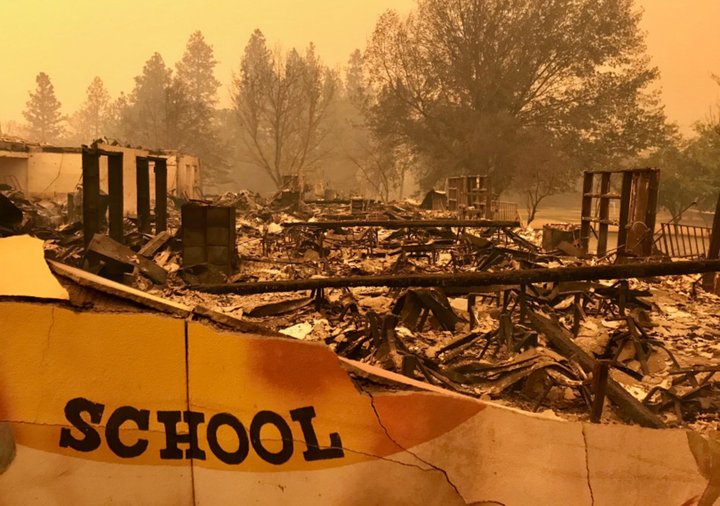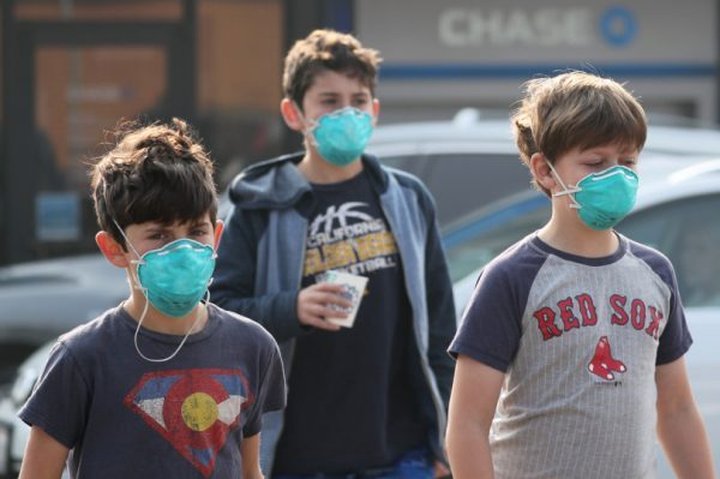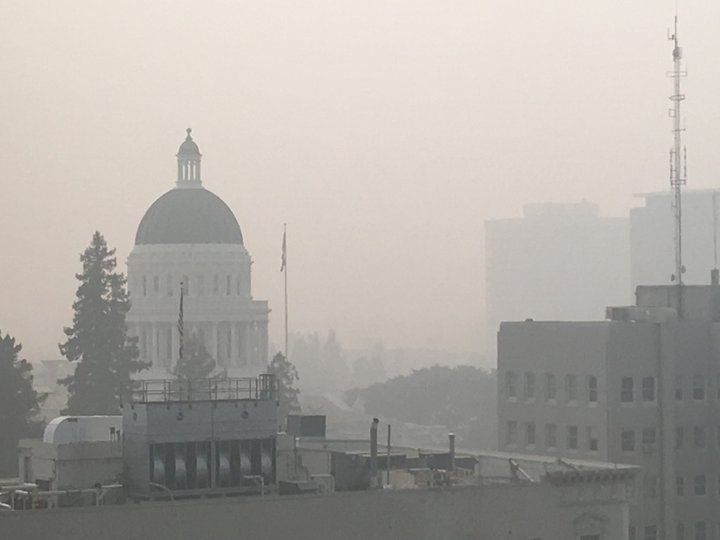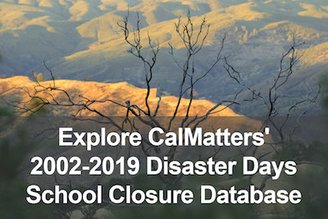
###
Each year, millions of Californians send their children to public K-12 classrooms, assuming that, from around Labor Day to early summer, there will be one given: A school day on a district’s calendar will mean a day of instruction in school. But that fixed point is changing, according to a CalMatters analysis of public school closures.
From massive wildfires to mass shooting threats to dilapidated classrooms, the 21st century is disrupting class at a level that is unprecedented for California’s 6.2 million students. Last year, the state’s public schools closed their doors and sent kids home in what appear to be record numbers, mainly as a result of sweeping natural disasters. It was the fourth significant spike in four years.
The trend largely tracks the rising frequency and severity of climate-fueled wildfires, with big bumps in 2003 and 2007, the years of San Diego County’s huge Cedar and Witch fires, and then, in recent years, a more sustained but equally dramatic climb with the historic wine country fires and Camp Fire of 2017 and 2018.
Every fifth student in California was sent home last year at least once for a natural disaster day, a maintenance crisis day, a threatened school shooting day or some other emergency.
But fire — which just this month shut down the entire Murrietta Valley United School District in Southern California — has not been the only big reason for lost school time. California students also lost instructional days for emergencies such as breakdowns in school facilities that make it unsafe to operate a normal school day — mold or plumbing problems, for instance — as well as threats of potential gun violence.
In the latter case, state data shows, even when school officials don’t deem a threat credible enough to cancel classes, fear alone has increasingly led parents to keep significant numbers of students at home.
Last school year, emergency closures in at least 2,262 schools – from the state’s most densely populated urban hubs to its most remote pockets – impacted more than 1.2 million students. The closures ranged from a single lost day to weeks without instruction. Put another way, roughly every fifth student in California was sent home in the 2018-19 school year at least once for a natural disaster day, a maintenance crisis day, a threatened school shooting day or some other emergency.

Children in Oakland wore dust masks on Friday, Nov. 16, 2018, as schools closed due to pollution from the Camp Fire in Paradise. Photo by Ray Chavez/Bay Area News Group
It’s a situation that has crept only gradually onto lawmakers’ radar, as the occasional break from routine has, in many districts, morphed into longer and more traumatic interruptions. Losses of 10 school days or more to wildfire — virtually unheard of in past decades — have occurred hundreds of times since 2015, impacting schools across California, from Oroville to Ojai.
The amount of missed school is key, according to education research. A 2015 study of math scores in wintery Massachusetts found that the occasional snow day didn’t impact performance, especially if the closure was one teachers could prepare for, but longer absences take a significant toll on learning. The challenges after a natural disaster also can remain overwhelming for educators even after schools reopen, as districts severely impacted by fires – such as Paradise Unified – have learned.
In an effort to understand how emergencies, disasters and threats impact the everyday operations of California’s public schools, CalMatters used the California Public Records Act to obtain records detailing thousands of emergency school closure incidents reported by local school districts to the state Department of Education since 2002-03 — as far back as the state has kept records. From those reports, we built our own database of school closures, spanning 17 school years and accounting for more than 34,000 total days of lost instruction.
A temporary change in California’s instructional requirements from 2009-10 to 2014-15, the years of the recession, may have depressed the number of closures reported to the state during those years. But since 2015-16, the state has recorded more school closures from wildfire and smoky air than at any point in the last two decades.
Here is what else CalMatters’ analysis found:
Widespread school closures have become more frequent. A big reason is wildfire.
In recent years, thousands of public schools statewide have reported closing for emergencies, citing a variety of reasons. But wildfire has been the cause in most years in which the numbers have spiked.
Recent fires have been especially disruptive. Of the more than 34,000 school closure days in CalMatters’ database, nearly two-thirds — 21,100 — stemmed from wildfires. Of these, more than half, or about 10,700, occurred since 2015. In some areas, the fire threat has been so relentless that some schools have closed as many as five times in the last four years for wildfires.
And those fire-related closures have gotten longer.
Until recently, only a handful of schools had reported losing more than 10 days in a single school year to wildfire-related emergencies. In the last two school years, that count has risen to nearly 300 schools. Before the 2015-16 school year, no California school had reported losing 15 days or more to wildfires. Since then, shutdowns of that duration have happened at more than 70 California schools.
Where there’s fire, there’s smoke — and that’s also keeping kids home.

Smoke from wildfires blanketed the Capitol and much of the rest of the state in 2018. Photo for CalMatters by Shawn Hubler
One of the most disruptive aspects of last year’s fire season was the billowing pollution it spewed for miles downwind of megafires. At one point in November, hazardous air quality from the Camp and Woolsey fires, among others, had prompted some 180 school districts, with a combined enrollment of more than 1 million students, to announce they would be cancelling school at some point that week.
Since then, California lawmakers have updated guidelines to help schools consistently determine when to close due to poor air quality.
But fire is far from the sole reason for California school closures.
Also substantial were closures due to extreme weather and natural disasters other than wildfires, such as floods and snowstorms. Infrastructure issues — electrical failures, asbestos, mold, insect infestations, contaminated water — also cut into class time.
Threats of the human variety have increasingly been an issue, whether from guns or epidemics of swine flu. And some schools have shut down for staffing shortages or even political reasons. Some San Diego County schools shut down in 2006 during mass immigration reform marches, for instance, and the Klamath-Trinity Joint Unified School District closed in late 2018 for a day of mourning after the death of former President George H.W. Bush.
Rural areas, where roads are often poor, have been particularly vulnerable to closures. In Humboldt County, Jack Norton Elementary, a remote two-room school with about 30 mostly Native American students that until last June relied on a generator for power, has lost more than 50 days of school since 2002 to closures for almost every imaginable reason, including torrential rains, wildfire, snow, collapsed roads, landslides, mold, power failures, social media threats, that presidential day of mourning and, in 2003-04, a “loose fugitive.”
Human threats have become an ongoing issue.
Less than 4% of lost school days were the result of violent threats to student safety, whether from gangs or bomb threats or social media warnings that a school shooting was about to occur. But the state records showed that those threats have become familiar, along with the disruption.
Between the 2002-03 and 2006-07 academic terms – the first five school years in the database – threats of violence resulted in closures at 117 schools. Among them: the April 2007 “copycat” threat that prompted systemwide closures in Yuba and Sutter Counties, from a 28-year-old man who allegedly vowed to commit a massacre that “would make Virginia Tech look mild.”
But in the last five school years – from 2014-15 to 2018-19 – such threats have forced school closures in more than 1,100 schools, a nearly 1,000% increase. Among them: a December 2015 bomb threat shortly after the terrorist shooting in San Bernardino that caused California’s largest school district, Los Angeles Unified, to close all its schools for one day.
With threats, though, closures are just part of the picture.
California also keeps separate records of incidents in which a school stays open but reports a sudden “material decrease” in attendance. CalMatters also studied those records, which describe emergencies that lead to attendance drops of more than 10% at a school site.
When it comes to student safety, those records show, mere threats of violence are increasingly keeping students home in significant numbers.
In the five school years from 2002-03 to 2006-07, some 11,400 student absences in 54 California schools were reported as part of “material decreases” in attendance. Since 2014-15, threat-related incidents have resulted in roughly 90,800 reported student absences in 300 schools.
In the 2012-13 school year — the year of Connecticut’s Sandy Hook Elementary School shooting — 51 California schools reported roughly 13,600 student absences as a result of violent threats, CalMatters found. And after the 2015 Los Angeles Unified bomb threat, attendance at some neighboring districts dipped markedly.
Crumbling schools are costing kids class time.
CalMatters also identified at least 370 instances in which schools had to close because of breakdowns in school facilities. They included schools that closed because broken pipes had left them no source of running water, schools found to have harmful traces of mold or asbestos, and schools that couldn’t safely operate because of other dilapidated facilities, such as broken septic tanks.
The situation reflects, among other things the glaring inequities in facilities among public schools in California. Of the districts represented in this pool of closures, 57 had not passed a single local bond in more than two decades, according to a separate CalMatters database of local school bond funding.
Local bonds are the driving force behind school facilities funding in California, as the amount local school districts are able to raise through voter-approved bonds significantly influences how much funding a district receives in state bond funds that mostly rely on matching funds.
Of the remaining 115 school districts in this group, 75 had less than the average per-student amount – about $19,000 per student – in funding from local bonds.
Lawmakers are playing catch-up.
After the 2017 Tubbs Fire in California’s wine country displaced nearly 1,500 students and 250 educators in school systems across Sonoma County, legislators started extending existing school funding protections for districts particularly impacted by wildfire. School funding, which is tied to attendance, was protected for three years in Santa Rosa, and, after the 2018 Camp Fire, in Paradise.
But state and local education officials say more comprehensive solutions — and more assistance — are needed. Suggestions made in interviews with CalMatters include:
- Require schools to make up at least some instructional days lost to emergency closures. Right now, that’s optional, and make-up days cost school districts money. CalMatters’ analysis found that some districts — in the Lake County community of Middletown, for instance — have lost five weeks of school time over the past four years.
- Protect state funding for schools shut down by disasters more uniformly, and for longer periods. Schools affected by wildfires say the impact is far more intense than Californians realize, and lasts longer because fires are more fierce and frequent. Fourteen of the 20 most destructive fires in state history have occurred in the last 12 years. Though the state has extended financial aid to the hardest-hit districts, assistance has been case-by-case, and so far only for up to three years. Paradise’s superintendent, for instance, has already said schools will need a longer grace period to avoid steep cuts to services and programs.
- Get serious about school-based mental health, especially in wildfire country. It isn’t just about funding, though that’s a big part of it, school officials say. Mental health professionals can be hard to find in rural parts of the state, where recent fires have done some of the most damage. Climate-driven crises appear to be happening closer together. And long after schools reopen after a disaster, teachers and students say they continue to struggle for normalcy.
###
Next: What shutdowns for wildfire have done to one California school district over the past four years. CALmatters.org is a nonprofit, nonpartisan media venture explaining California policies and politics.

CLICK TO MANAGE